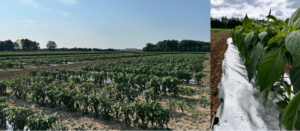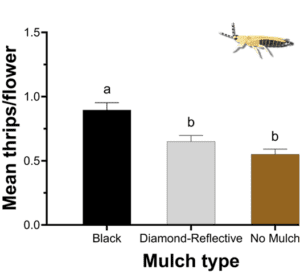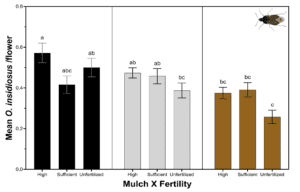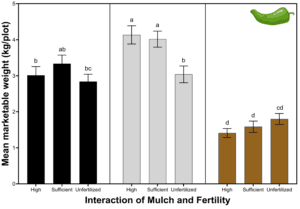Feb 6, 2025Veg Connections: Thrips Management in Peppers and IPM Strategies for Sustainable Yield
Thrips remain one of the most damaging pests in pepper fields. They cause flower abortion, foliage loss, fruit scarring, and transmit tospoviruses. When populations surge, thrips can sharply reduce yield. Pepper growers often rely on insecticides, but overuse increases resistance risk and threatens long-term effectiveness.
Balancing Pest Control and Beneficials
Heavy reliance on broad-spectrum insecticides also harms beneficial insects. Minute pirate bugs, key predators of thrips, decline under chemical-intensive program. This loss reduces natural control options, underscoring the importance of sustainable thrips management strategies that conserve beneficial insects.
Designing an IPM Program for Thrips

Researchers tested an integrated pest management (IPM) program that combined insecticide use, mulch types, and fertility levels (NPK). These strategies aimed to reduce thrips damage while sustaining beneficial insect populations and protecting yield.
Reflective mulches and lower fertility have shown promise in reducing thrips pressure. The team evaluated how these practices, alongside weekly insecticide applications, influenced thrips and minute pirate bug populations in peppers.
The study tested 18 treatment combinations, pairing three mulch types (black mulch, diamond-silver reflective mulch, and bare soil) with three fertility levels (high NPK, sufficient NPK, and unfertilized). Trials ran across two growing seasons (2023 – 2024) at the North Central Ohio Agricultural Research Station.
Thrips Populations Respond to Treatments

Insecticides, mulch, and fertility each influenced thrips density. Weekly applications of Radiant SC significantly reduced thrips compared to untreated controls.
Mulch had a clear impact: diamond-reflective mulch and bare soil supported fewer thrips, while black mulch harbored the most. Reflective mulch appeared to disrupt thrips’ ability to locate plants, while black mulch provided favorable conditions.
Nutrient levels also mattered. Thrips preferred high- and sufficient-NPK plots, while unfertilized plots supported the lowest densities. Although modest, this trend confirmed that thrips thrive on nutrient-rich plants.
Minute Pirate Bug Populations

Minute pirate bug abundance depended on mulch and fertility combinations. Black mulch paired with high fertility produced the most pirate bugs. Reflective mulch paired with high or sufficient fertility also supported strong populations, showing that reflective mulches did not deter beneficial predators.
Marketable Yield Benefits

Marketable yield increased when insecticides paired with reflective mulch. These plots produced the highest yields, while untreated plots without mulch yielded the lowest.
Reflective mulch combined with sufficient or high fertility consistently produced strong yields. In contrast, no-mulch plots performed worse regardless of fertility, suggesting mulch plays a key role in preserving soil nutrients and improving availability to pepper plants.
Takeaways for Thrips Management
This study highlights the value of combining reflective mulches, fertility management, and targeted insecticide use in thrips management. These IPM strategies reduce dependencies on chemicals, support natural predators, lower input costs, and sustain yields in Midwest pepper production.
Arnold Gomez is a Ph.D. student working under Dr. Ashley Leach, whose research focuses on developing alternative and effective integrated pest management combining insecticides and cultural controls to manage thrips while conserving beneficial insect populations in pepper agroecosystems.
Ashley Leach is an assistant professor and state Extension specialist dedicated to advancing sustainable pest management strategies for specialty crops. Her research and Extension work focus on developing evidence-based Integrated Pest Management programs that reduce reliance on insecticides, benefiting both growers and the environment.
















